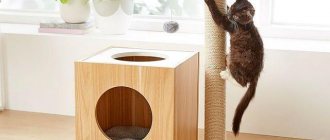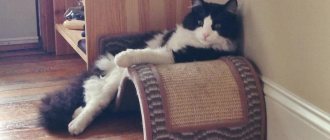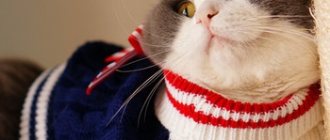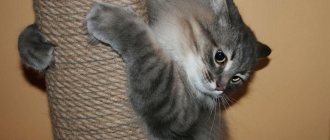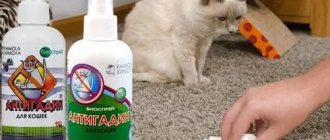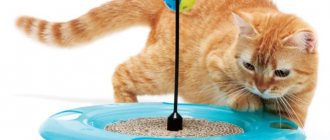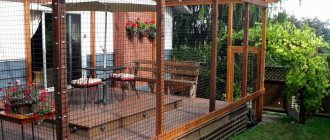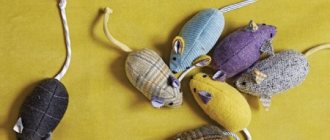Cats, depending on their breed, have different temperaments. Some are calm and slow. These are passive breeds, such as Persian, Ragdoll, Selkirk Rex, Exotic Shorthair, etc. They are reluctant to play and move little. Their complete opposite is active breeds, such as Siamese, Abyssinian, Balinese, Kurilian Bobtail, etc. They are very energetic, have a well-developed hunting instinct and need constant movement. A running wheel will help such pets.
Benefits of a running wheel
In fact, the simulator will be useful for a cat with any character. Energetic animals will be able to run around in it to their heart's content, and calm ones will be able to shake out their fat a little. The problem of excess weight is especially acute in castrated and sterilized cats. For them, the wheel will be an effective way to lose a couple of extra pounds. The owner should remember that obesity in an animal is also fraught with problems with the heart and joints, just like in humans. In addition, your pet will appreciate the original design of the wheel. He will clearly enjoy the activity - depression will go away and his mood will improve.
You can make a running wheel for cats yourself. Self-production will allow you to save not only a decent amount of money (from 10 to 25 thousand rubles), but also as a result you will get an original design that no one else will have. However, before you start purchasing materials, you should study the information about what the wheel should be like so that the cat likes it.
Who needs it?
A running wheel is a kind of exercise machine, which is primarily needed by active domestic cats. Space in apartments is quite limited and animals do not have the opportunity to express all their energy. If you prevent an active pet from playing, then over time he may become lazy and spend most of his time sleeping or at the food bowl.
Passive individuals have an increased risk of gaining excess weight, which, in turn, can lead to serious health problems. A running wheel will be an excellent alternative to free-ranging on the street for natural predators.
Among all cats, representatives of the following breeds are distinguished by activity:
- Abyssinian;
- Somali;
- Egyptian Mau;
- savannah;
- Bengal;
- oriental;
- Siamese;
- Ocicat.
However, this does not mean that only these animals will like the simulator. Any cat can be active, regardless of its breed.
What you need to know about the running wheel
For the “cat simulator” to be successful, it is not enough to have all the necessary tools and preparations. It is important that the cat likes the final design. To do this, it must meet the following requirements:
- Large wheel diameter. The cat will not have to bend its body unnaturally if the size of the circle allows it to keep its back straight. In pet stores you can find wheels with a height of 80 and 120 cm, but this is not the limit. If, for example, a Maine Coon is going to jog in it, then the diameter of the wheel can be made even larger.
- Non-slip interior coating. If a cat’s paws constantly move while running, then she will definitely soon get tired of this activity. In the best case, the animal will simply jump out of the simulator, and in the worst case, it may twist its paw. So the ideal covering would be carpet or felt.
- Wheel structure. If the cat is very active and passionate, then a running wheel with an inner wall is best suited for him. It will be able to prevent the animal from “flying out” while running, and coordinate its trajectory of movements.
How to choose?
When choosing a running wheel, first of all you need to take into account the amount of free space in the apartment that can be allocated for installing the exercise machine. You also need to consider the number of cats in the house, their height and weight. For a large number of animals or for a large pet, massive, stable, semi-closed models are best suited.
Veterinarians recommend not using wheels with a diameter of less than one meter. The width of the path should not be less than thirty centimeters. Otherwise, the animal may damage its spine while exercising on small exercise machines.
When purchasing a finished model in a store, you must carefully inspect the entire structure. A product made of low-quality materials or with poor fastenings can, at best, not last long, and at worst, cause injury to your pet.
The inner surface of the wheel should not be slippery. It is best if it is covered with carpet or felt. Exercise machines differ in appearance and can be of different colors, so you can choose the right option for any interior.
Method one
This option will be quite difficult for craftsmen who have never cut into a bearing or installed rollers. More experienced craftsmen will be able to figure it out without difficulty, since photos are posted as tips.
To work you will need:
- plywood;
- Miter saw;
- rail;
- rollers;
- pencil;
- Dremel;
- centimeter;
- bearing;
- beam;
- rope;
- fasteners;
- carpet;
- drill;
- glue;
- sander;
- bolt with nut;
- pipes;
- knife;
- double sided tape.
The sequence of actions can be divided into seven stages:
- Creating a foundation. Two circles of plywood with a radius of 46 cm are cut out, which will be the base of the wheel. They are connected to each other using bars.
- Manufacturing of slats. The slats are glued around the end part. For greater strength they are secured with straps.
- Installation on rollers. Two semicircular stands are equipped with two rollers on both sides, on which the running wheel will subsequently be installed. It is due to them that the simulator will rotate.
- Wall installation. Another circle is cut out of plywood and glued to the support. In the future, a bearing will be attached to it.
- Axle placement. Since the running wheel rotates on an axis consisting of a bolt with a bushing, to install it it is necessary to strengthen the insertion point. To do this, a plywood square is glued to the back side of the wall, and a gear is placed in front. A hole is drilled in the center.
- Making a stand. It is made from a support and bars made in the form of a rack. Two boards are fixed on it, into which bearings are installed.
- Gluing the track. A strip of carpet is cut along the width of the wheel. It should be glued with double-sided tape.
How to do it yourself?
If you have the necessary materials and tools, you can make the simulator yourself. It won't take much time and won't cost much. The easiest way would be to make a wooden wheel. To make it you will need the following materials and tools:
- wood grinding machine;
- thick sheets of plywood;
- carpet or felt;
- tape measure and rope;
- construction pencil;
- bolts and nuts;
- Miter saw;
- small wheels;
- construction adhesive;
- wooden slats and beams;
- fasteners;
- knife and drill;
- bearings.
First of all, on sheets of plywood it is necessary to mark the boundaries of two circles that will serve as a frame for the future simulator. It is desirable that the diameter of each be at least one meter. Next, you need to cut out two circles and fasten them together at a distance of at least thirty centimeters using bars.
The bars, in turn, are fastened to the plywood using a screwdriver, glue or ordinary nails. The empty cavity between the circles needs to be closed and this is done by gluing slats around the circumference of the wheel. To make the structure stronger, the slats are tied with a thick rope or belt.
When all the elements of the wheel are glued together, you will need to cut out one or two sides, depending on the type of future structure. Next, you need to make a stand with wheels and attach it either to the side wall of the drum or directly under it.
To make the stand you will need two small pieces of plywood in the shape of a semicircle. A pair of rollers are installed on both sides, which will rotate the structure. For a semi-closed design, it is necessary to make a special axle for rotation and attach it to the side wall of the wheel.
The finished wooden structure must be coated with a special compound that prevents wood from rotting. The inner surface should be finished with felt or carpet. You can attach pieces of material with double-sided tape, but it will be more reliable to use glue.
Method two
This option requires the presence of a welding machine, and the manufacturing algorithm is a little simpler than the previous one. To make a running wheel for cats with your own hands according to the instructions you will need:
- steel profile;
- plywood;
- wooden barrel;
- boards;
- bearings;
- wire;
- fasteners and wrench;
- welding machine;
- dye;
- drill;
- jigsaw;
- roulette.
The sequence of actions consists of three stages:
- Creating a frame on which the wheel will be attached. To do this, you need to weld a rectangular frame from a steel profile. Immediately on the long side, retreating 10 cm from the edge, weld the crossbar. Also attach two hinge posts to it through welding at an angle of 30-45 degrees.
- Making the running wheel itself. Cut off part of the barrel. To prevent the boards from falling apart, they need to be bolted together. Cut out the back wall for the drum from plywood. The circumference should be slightly smaller than the inner diameter of the narrow part of the barrel.
- Assembly of the structure. Attach the drum to the hinge so that it can rotate freely. This should be done so that the wheel rotates only forward and backward, and does not sway left and right.
Regardless of whether the running wheel for cats is made with your own hands or purchased from a specialized store, it must be securely fastened. This is important so that when the cat jumps, it does not knock over the structure and injure itself.
If the running wheel is made according to all recommendations and securely fixed in the house, you can be sure that it will become one of your mustachioed pet’s favorite places to spend active time.
Advantages and disadvantages
Running wheels for cats have both advantages and disadvantages. Let's consider the advantages of such a simulator.
- The wheel allows you to organize leisure time for your pet. Individuals who like to run around the apartment in the mornings and nights will no longer bother tired owners and wake them up.
- The health benefits for cats are undeniable. For lazy individuals, periodic jogging allows you to maintain normal weight and not gain fat. Active pets will be able to splash out their energy at any time. Exercise also helps maintain muscle tone.
- Exercising on a treadmill not only allows you to maintain normal weight and train muscles, but also has a beneficial effect on the cardiovascular system and lungs.
- In many wheel models, the inside is lined with carpet and can serve as a scratching post for your pet.
As for the disadvantages, they are not so significant for running wheels. Let us highlight the main disadvantages of the simulator.
- Ready-made models are quite expensive . However, on the Internet you can find ready-made drawings and instructions for making such wheels, which will save money.
- Some exercise machines are quite large and are only suitable for large rooms.
- Not all cats are ready to immediately appreciate all the advantages of a running wheel. The owner sometimes has to spend a lot of time to accustom his pet to the exercise machine.
Running wheels are not suitable for all cats. And it's not always about the animal's temperament. If the cat has any injuries or illnesses, training on the simulator may not be acceptable.
Varieties
All running wheels have the same operating principle. Ready-made models of exercise equipment for cats primarily differ in size, material of manufacture and appearance.
Wheels can be of different diameters: small designs are designed only for kittens , and therefore after the animal grows up, they will become unnecessary. Large exercise machines are more practical and will come in handy, especially if there are several cats living in the house.
As for materials, they can be very different. The most commonly used materials are wood, plastic and metal. Simple kitten models can also be made from cardboard . Wood is considered the most versatile option in this case.
Let's consider these options.
- Wood is initially an environmentally friendly material and will not cause allergies in animals or other inhabitants of the house. Typically, exercise machines made of wood are quite lightweight and can be easily moved to a new location. Also, wooden models will fit well into almost any interior.
- Plastic wheels are lightweight and small in size. However, such structures cannot be called reliable and durable. They are quite unstable, and if any part of the simulator breaks, replacing it will be extremely problematic.
- Metal models are the heaviest, but at the same time they are stable and reliable. Moving the structure to a new location will be a little problematic. But the likelihood that the wheel will quickly fail is extremely small. Typically, such models are made to order or independently, if you have experience working with welding equipment.
- Cardboard wheels can hardly be called a full-fledged exercise machine. Such models are designed exclusively for kittens and small breed cats. With a high probability, animals will use the product for other purposes and, instead of training, will prefer to tear off pieces of cardboard from it.
Several materials can be used for manufacturing. At home, you can make a wheel of the desired size and characteristics.
As for the design, there are open and half-closed types of wheels. In open models, the wheel has no side walls. Semi-closed options imply the presence of one partition. Open exercise machines rotate due to rollers, which are mounted on a stand located under the wheel. In closed models, the rotation mechanism is located on the side, so such simulators are considered more stable.
